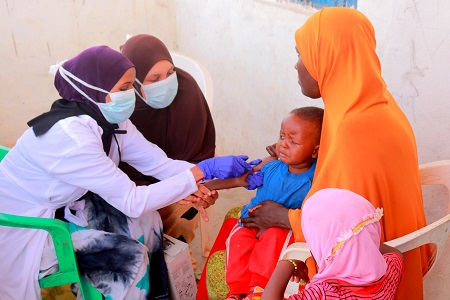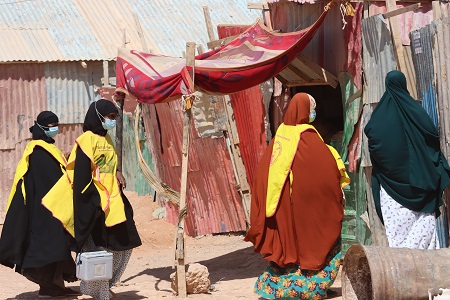 The measles immunization campaign vaccinated close to half a million children aged from 6 to 59 months to boost their immunity. Credit: WHO/Mukhtar Sudani10 August 2022 – In the Washington camp for internally displaced persons (IDPs) in Garowe, Deka Abdi Dacar learnt about measles, known as jadeeco in Somali after her experience. She lost 2 of her 4 children, aged 2 and 4, as they had measles with other complications. Both her young sons had fever, coughs and a rash for a few days before Deka and her family took them to the hospital. She solemnly adds that although she really regrets not knowing about measles vaccines before, she is still grateful she managed to vaccinate 2 of her children.
The measles immunization campaign vaccinated close to half a million children aged from 6 to 59 months to boost their immunity. Credit: WHO/Mukhtar Sudani10 August 2022 – In the Washington camp for internally displaced persons (IDPs) in Garowe, Deka Abdi Dacar learnt about measles, known as jadeeco in Somali after her experience. She lost 2 of her 4 children, aged 2 and 4, as they had measles with other complications. Both her young sons had fever, coughs and a rash for a few days before Deka and her family took them to the hospital. She solemnly adds that although she really regrets not knowing about measles vaccines before, she is still grateful she managed to vaccinate 2 of her children.
Prevalence of measles
Measles has been endemic in Somalia for years. One of the largest outbreaks was reported in 2017, when 23 039 suspected cases were reported across 118 of the country’s operational districts and the Banadir administrative region.
Since then, the prevalence of measles has varied each year. In 2020, Somalia recorded 9562 suspected measles cases, and a year later, in 2021, the country reported 7494 suspected measles cases. From January to July 2022, the country has had 11 972 suspected measles cases, which is a large spike as compared to previous years.
Drought increasing chances of measles spreading
Over the years, Somali children like Deka’s have had to bear the brunt of fragile health systems, an underpaid health workforce that has limited skills, low levels of health education among the population, and protracted conflict and insecurity.
Recurring emergencies in Somalia add on to health challenges that communities face, and resulting mass displacement fuels the spread of diseases. As a result of the drought that hit Somalia in 2021, an estimated 1.5 million children aged under 5 years face acute malnutrition, with over 380 000 likely to experience severe malnourishment. Children who are severely malnourished are at a high risk of falling ill – they are 9 times more likely to die of diseases such as measles, or acute watery diarrhoea/cholera.
The drought, which is showing signs of turning into imminent famine, has affected 7 countries in the Greater Horn of Africa - Djibouti, Ethiopia, Kenya, Somalia, South Sudan, Sudan and Uganda. Six of these countries, including Somalia, are witnessing measles outbreaks.
“As long as Somalia and neighbouring countries have pockets of under-immunized children and low routine immunization rates, preventable diseases like measles will keep reversing gains made so far and affecting children,” said Dr Mamunur Rahman Malik, WHO Representative to Somalia. “WHO-UNICEF estimates state that only around 46% of children in Somalia have received their first dose of measles in the last decade. We all need to redouble our efforts to reach the other half of the population of children, especially as COVID-19 has already contributed to childhood immunization sliding backwards in Somalia.”
Measles vaccination campaign reaches over 459 000 children
 Health care workers, many of whom are women, focus on vulnerable communities and children while delivering health services. Credit: WHO/Mukhtar SudaniTo prevent measles from spreading, the World Health Organization (WHO) and United Nations Children’s Fund (UNICEF) provided crucial support to the Puntland and Galmudug Ministries of Health to conduct a measles vaccination campaign from 20 to 29 July 2022. The campaign covered children in 15 districts in Puntland and 2 districts in Galmudug.
Health care workers, many of whom are women, focus on vulnerable communities and children while delivering health services. Credit: WHO/Mukhtar SudaniTo prevent measles from spreading, the World Health Organization (WHO) and United Nations Children’s Fund (UNICEF) provided crucial support to the Puntland and Galmudug Ministries of Health to conduct a measles vaccination campaign from 20 to 29 July 2022. The campaign covered children in 15 districts in Puntland and 2 districts in Galmudug.
As part of the intervention, 466 outreach teams vaccinated 459 478 children aged from 6 to 59 months out of a targeted 487 909 (94% of the target), according to preliminary data collected and analyzed. Two thirds of the outreach vaccination teams were deployed in urban areas, while a third focused on camps and households in rural areas. Additionally, 83 supervisors and monitors were deployed to maintain the quality of services provided and ensure that vaccinators were following COVID-19 protocols while interacting with communities. During the campaign, social mobilizers shared messages about the dates of the campaign, location of vaccination sites and benefits of vaccination with communities.
The campaign had a special focus on children from vulnerable populations, including those living in internally displaced camps.
Support from partners and health workers going a long way
Dr Mamunur Malik, the Head of the Mission of WHO Somalia, also expressed his profound gratitude to donors such as Gavi - the Vaccine Alliance, the European Union (EU) Delegation to Somalia, European Civil Protection and Humanitarian Aid Operations of Somalia, as well as the donors contributing to Contingency Funds for Emergencies of WHO for supporting, safeguarding and protecting vulnerable Somali children, living in some of the worst, life-threatening conditions caused by the current drought, occurring in a challenging environment.
With support from partners, Somalia introduced the second dose of measles-containing vaccine (MCV2) in children’s routine immunization schedule in November 2021, around the same time the Government declared the drought a national emergency in the country.
In general, communities are also supportive of health service delivery in the country. Asha Ali, a vaccinator who was involved in the measles campaign explains, “Somali parents are usually supportive of vaccination campaigns. However, I did meet 3 families who refused to get their children vaccinated initially. After we explained the benefits of vaccination, along with social mobilizers and supervisors, they agreed to vaccinate their children. It makes me happy to see situations like this, where we can make a difference to keep children healthy.”
Additional information on the drought and measles in Somalia can be found below:
WHO launches appeal to respond to urgent health needs in the greater Horn of Africa
WHO EMRO | Protecting children from measles in drought-affected Somalia | News | Somalia site








